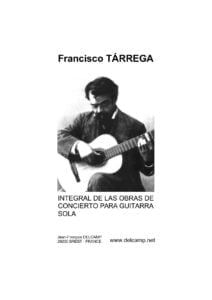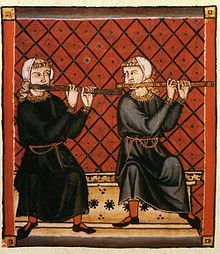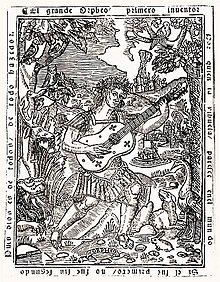Browse in the Library:
Search Posts by Categories:
A Spanish Musical Portrait: Llobet, Tárrega, Granados, Albeniz
A Spanish Portrait: Llobet, Tárrega, Granados, Albeniz


Descargar estas y otras muchas más partituras en nuestra biblioteca.
Browse in the Library:
Find this guitar sheet music in our Library.
Composer: Enrique Granados, Francisco Tárrega, Isaac Albéniz
Artists: Luigi Attademo historical Torres guitar
A musical portrait of a master guitar-maker of the 19th century. Great instruments have always been associated with great musicians, and this is true in the guitar world too, at least from the early 19th century onwards. Early in his career, Antonio de Torres (1817-1892), like other luthiers before him, found a performer ideally suited to his instruments – the young Andalusian guitarist Julián Arcas.
The technical innovations in construction and timbre pioneered by Torres enabled Arcas to give full expression to his artistry in works such as the florid Fantasía sobre El paño o sea Punto de La Habana with which Luigi Attademo opens this new studio album.
Tracklist:
00:00:00 Fantasía sobre el paño o sea punto de la Habana 00:05:23 El delirio 00:09:46 Adelita in E Minor 00:11:11 Sueño 00:12:47 Mazurka en sol 00:15:13 Marieta 00:17:13 Danza española No. 5 “Andaluza” 00:22:06 Preludio No. 5 in E Major
00:23:43 Preludio No. 2 in A Minor 00:25:46 Preludio No. 1 in D Minor 00:27:10 Endecha y oremus 00:28:11 Leyenda 00:36:02 12 Piezas características, Op. 92: XII. Torre bermeja, serenata 00:40:49 Cançó del lladre 00:42:20 El testament d’Amelia in D Minor 00:44:06 Lo fill del rei 00:45:47 Plany 00:47:45 Variaciones sobre un tema de Sor
Music of Spain
The music of Spain has a long history. It has played an important role in the development of Western music, and has greatly influenced Latin American music. Spanish music is often associated with traditional styles such as flamenco and classical guitar. While these forms of music are common, there are many different traditional musical and dance styles across the regions.
For example, music from the north-west regions is heavily reliant on bagpipes, the jota is widespread in the centre and north of the country, and flamenco originated in the south. Spanish music played a notable part in the early developments of western classical music, from the 15th through the early 17th century.
The breadth of musical innovation can be seen in composers like Tomás Luis de Victoria, styles like the zarzuela of Spanish opera, the ballet of Manuel de Falla, and the classical guitar music of Francisco Tárrega. Nowadays commercial pop music dominates.
Origins of the music of Spain

Musical instruments in the Diocesan Museum of Albarracín.
The Iberian peninsula has had a history of receiving different musical influences from around the Mediterranean Sea and across Europe. In the two centuries before the Christian era, Roman rule brought with it the music and ideas of Ancient Greece; early Christians, who had their own differing versions of church music arrived during the height of the Roman Empire; the Visigoths, a Romanized Germanic people, who took control of the peninsula following the fall of the Roman Empire; the Moors and Jews in the Middle Ages. Hence, there have been more than two thousand years of internal and external influences and developments that have produced a large number of unique musical traditions.
Medieval period

Cantigas de Santa maría, medieval Spain
Isidore of Seville wrote about the local music in the 6th century. His influences were predominantly Greek, and yet he was an original thinker, and recorded some of the first details about the early music of the Christian church. He perhaps is most famous in musical history for declaring that it was not possible to notate sounds, an assertion which revealed his ignorance of the notational system of ancient Greece, suggesting that this knowledge had been lost with the fall of the Roman Empire in the west.

Codex Las Huelgas, a medieval Spanish music manuscript, circa 1300 AD.
The Moors of Al-Andalus were usually relatively tolerant of Christianity and Judaism, especially during the first three centuries of their long presence in the Iberian peninsula, during which Christian and Jewish music continued to flourish. Music notation was developed in Spain as early as the 8th century (the so-called Visigothic neumes) to notate the chant and other sacred music of the Christian church, but this obscure notation has not yet been deciphered by scholars, and exists only in small fragments.
The music of the early medieval Christian church in Spain is known, misleadingly, as the “Mozarabic Chant“, which developed in isolation prior to the Islamic invasion and was not subject to the Papacy’s enforcement of the Gregorian chant as the standard around the time of Charlemagne, by which time the Muslim armies had conquered most of the Iberian peninsula.
As the Christian reconquista progressed, these chants were almost entirely replaced by the Gregorian standard, once Rome had regained control of the Iberian churches. The style of Spanish popular songs of the time is presumed to have been heavily influenced by the music of the Moors, especially in the south, but as much of the country still spoke various Latin dialects while under Moorish rule (known today as the Mozarabic) earlier musical folk styles from the pre-Islamic period continued in the countryside where most of the population lived, in the same way as the Mozarabic Chant continued to flourish in the churches.
In the royal Christian courts of the reconquistors, music like the Cantigas de Santa Maria, also reflected Moorish influences. Other important medieval sources include the Codex Calixtinus collection from Santiago de Compostela and the Codex Las Huelgas from Burgos. The so-called Llibre Vermell de Montserrat (red book) is an important devotional collection from the 14th century.
Renaissance and Baroque periods

Orpheus playing the vihuela. Frontispiece from the famous work El maestro by Luis de Milán, 1536.
In the early Renaissance, Mateo Flecha el Viejo and the Castilian dramatist Juan del Encina ranked among the main composers in the post-Ars Nova period. Renaissance song books included the Cancionero de Palacio, the Cancionero de Medinaceli, the Cancionero de Upsala (kept in Carolina Rediviva library), the Cancionero de la Colombina, and the later Cancionero de la Sablonara. The organist Antonio de Cabezón stands out for his keyboard compositions and mastery.
An early 16th-century polyphonic vocal style developed in Spain was closely related to that of the Franco-Flemish composers. Merging of these styles occurred during the period when the Holy Roman Empire and the Burgundy were part of the dominions under Charles I (king of Spain from 1516 to 1556), since composers from the North of Europe visited Spain, and native Spaniards traveled within the empire, which extended to the Netherlands, Germany and Italy.
Music composed for the vihuela by Luis de Milán, Alonso Mudarra and Luis de Narváez was one of the main achievements of the period. The Aragonese Gaspar Sanz authored the first learning method for guitar. Spanish composers of the Renaissance included Francisco Guerrero, Cristóbal de Morales, and Tomás Luis de Victoria (late Renaissance period), all of whom spent a significant portion of their careers in Rome.
The latter was said to have reached a level of polyphonic perfection and expressive intensity equal or even superior to Palestrina and Lassus[citation needed]. Most Spanish composers returned home from travels abroad late in their careers to spread their musical knowledge in their native land, or in the late 16th century to serve at the Court of Philip II.
18th to 20th centuries

By the end of the 17th century the “classical” musical culture of Spain was in decline, and was to remain that way until the 19th century. Classicism in Spain, when it arrived, was inspired by Italian models, as in the works of Antonio Soler. Some outstanding Italian composers such as Domenico Scarlatti and Luigi Boccherini were appointed to the Madrid royal court. The short-lived Juan Crisóstomo Arriaga is credited as the main beginner of Romantic sinfonism in Spain.[citation needed]
Massiel She won the Eurovision Song Contest 1968 with the song “La, la, la“, beating the British pop singer Cliff Richard‘s “Congratulations“.
Although symphonic music was never too important in Spain, chamber, solo instrumental (mainly guitar and piano) vocal and opera (both traditional opera, and the Spanish version of the singspiel) music was written by local composers. Zarzuela, a native form of opera that includes spoken dialogue, is a secular musical genre which developed in the mid-17th century, flourishing most importantly in the century after 1850.
Francisco Asenjo Barbieri was a key figure in the development of the romantic zarzuela; whilst later composers such as Ruperto Chapí, Federico Chueca and Tomás Bretón brought the genre to its late 19th-century apogee. Leading 20th-century zarzuela composers included Pablo Sorozábal and Federico Moreno Torroba.
Fernando Sor, Dionisio Aguado, Francisco Tárrega and Miguel Llobet are known as composers of guitar music. Fine literature for violin was created by Pablo Sarasate and Jesús de Monasterio.
Musical creativity mainly moved into areas of popular music until the nationalist revival of the late Romantic era. Spanish composers of this period included Felipe Pedrell, Isaac Albéniz, Enrique Granados, Joaquín Turina, Manuel de Falla, Jesús Guridi, Ernesto Halffter, Federico Mompou, Salvador Bacarisse, and Joaquín Rodrigo.
